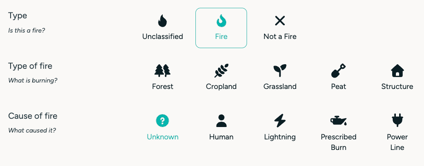Classifications: WFS as Fire Management Platform
Coordinate your responses more effectively
In this article, we'll cover:
While WFS is commonly viewed as a platform for Early Detection and Fire Monitoring, it is, in fact, a comprehensive Fire Management Platform.
Benefits of Classifications and Incident Status
Assigning a Classification and a Incident Status to clusters provides a comprehensive view of each event’s current situation.
This clarity allows your team to make quick, data-driven decisions—whether it’s dispatching resources or monitoring for additional satellite data.
⚠️ Classifications and Status are shared and thus affect all users from your organization. Please be sure of the classification of a cluster or the status of a specific fire before doing so in WFS.
The Incident Overview provides a real-time snapshot of all events, making essential details readily accessible. Additionally, properly classified clusters ensure that alerts and notifications are tailored to the event’s specifics, enhancing situational awareness and response efficiency.
If you want to understand how to classify your events, please refer to our How To Classify Events Article.
By setting a Classification you identify whether a cluster is an actual fire or not.
Once confirmed, you can further specify details about the nature of the fire, including what materials or vegetation were burned and the potential cause. This distinction helps create a detailed record, supporting both immediate response and long-term analysis.

Incident Status
The Incident Status reflects the response stage of an incident.
You can mark it as “Noted” if more data is needed, indicate if firefighters have been dispatched, update it to “Attended” if teams are actively managing the incident, or mark it as “Closed” once the fire has been fully addressed.
This status tracking keeps everyone informed of the response progress, reducing redundancies and optimizing resource allocation.

Why Classifications Matter
Effective event classification is a cornerstone of proactive fire management. Here’s why maintaining accurate and timely classifications is crucial:
-
Real-Time Situational Awareness
Classification keeps users informed about the exact nature of each cluster within their Monitored Areas, indicating whether it represents a verified fire event, potential threat, or false alarm. This awareness allows teams to allocate resources precisely where they are needed most. -
Enhanced Response Coordination
By knowing if a fire is confirmed and whether responders are actively addressing it, fire management teams can make more informed decisions about dispatching resources. For instance, identifying that firefighting teams are already on-site reduces redundant deployments, freeing up resources for other incidents. -
Risk Prioritization and Resource Allocation
Classification allows managers to prioritize incidents based on severity and proximity to critical infrastructure, assets, or populated areas. This targeted response is essential during peak wildfire seasons when multiple clusters may emerge simultaneously. -
Historical Data for Post-Incident Analysis
Each classification entry serves as part of the incident’s record, providing valuable data points that can be reviewed later to evaluate response effectiveness, improve future strategies, and identify patterns in fire behavior. -
Clear Communication with Stakeholders
When classification statuses are consistently updated, all stakeholders—whether internal teams, government agencies, or local communities—have a unified understanding of each event’s status, fostering trust and transparency in wildfire management efforts.
Classifying events not only streamlines immediate firefighting efforts but also supports long-term strategy and collaboration by ensuring that fire data is current, reliable, and accessible across all relevant teams and stakeholders.
